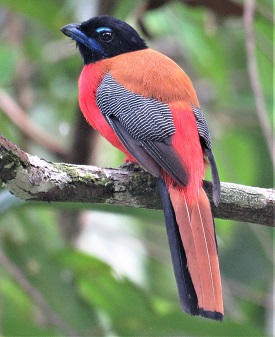 NEW! SABAH: Borneo's Wildlife Paradise NEW! SABAH: Borneo's Wildlife Paradise
Sabah, the Malaysian state that occupies the northern part of Borneo island, harbors large tracts of lowland and montane rainforest and is home to vast array of stunning birds including more than 40 endemics. With the country's highest peak, Mount Kinabalu, lush tropical forests and wildlife filled riverine habitats, Sabah is a a must visit destination for birders and wildlife enthusiasts. Brightly colored Pittas and Broadbills, the extraordinary Great Argus, Bornean Bristlehead, Whitehead’s Trogon, Whitehead's Broadbill, Storm’s Stork, all add to the exotic allure of Sabah, as does the chance to see a variety of primates including Proboscis Monkeys and Orangutans. This presentation describes the unique wildlife of Sabah with vivid photographs and anecdotes and chronicles what it is like to experience Borneo's wildlife paradise.
Scarlet-rumped Trogon, Borneo. Photo by Gina Nichol.
Back to top
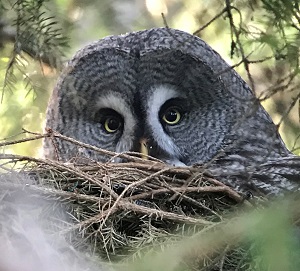 NEW! THERE'S SOMETHING ABOUT OWLS NEW! THERE'S SOMETHING ABOUT OWLS
Owls
are much loved in the bird
world and seeing any owl is
indeed a thrill. The secretive
lives of owls are part of
their mystique and can make
them very difficult to find
in the wild. "There's Something About Owls" goes
beyond the incredible adaptations
of owls and reveals strategies
to increase your chances of
seeing owls in your backyard,
your local patch, and beyond.
Preparation for your search,
ethical field practices, skills,
and tactics for success are
discussed and illustrated
with anecdotes and experiences
from the field. Suggestions
for what you can do to help
owls are also included.
Great Gray Owl. Photo by Gina Nichol.
Back to top
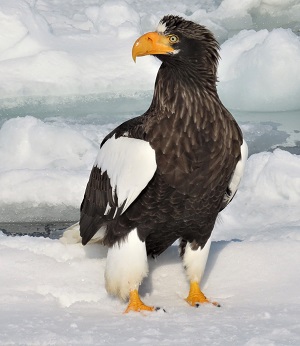 NEW! WINTER
WONDERS
OF JAPAN NEW! WINTER
WONDERS
OF JAPAN
The winter wildlife of Japan offers a number of spectacles unmatched in the wild! Tens of thousands of Cranes of at least 5 species can be seen feeding on snowy fields or flying into roost against the backdrop of glorious sunsets in Kagoshima. The famous dancing Red-crowned Cranes are in full performance in Kushiro. Snow Monkeys (Japanese Macaques) frolic in hot thermal pools in the Jigokudani valley. Japanese Murrelets come to near shore islands to breed. Steller’s Sea-Eagles, White-tailed Eagles, hordes of seabirds and ducks winter on and around Hokkaido. And, if you know where to go, you can watch the massive Blakiston’s Fish-Owl catch fish right out your bedroom window! This program reveals the winter wildlife of Japan with vivid photos and anecdotes from travels around this island nation of eastern Asia.
Steller's Sea Eagle, Japan. Photo by Gina Nichol.
Back to top
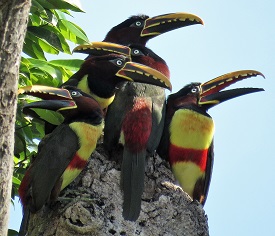 NEW! FLOCKOLOGY! NEW! FLOCKOLOGY!
Unraveling
the
Mysteries
of
Bird Flocks
As
birders and wildlife enthusiasts,
we can't help but marvel at large
gatherings of birds. Many bird
species spend time in flocks that
can range in size from just a
few birds to tens of thousands,
even millions. Flocks of birds,
whether they be in the air or
on the ground, can offer a magnificent
spectacle. This presentation asks
the question, why do birds form
flocks? It explores the phenomenon
of bird gatherings with vivid
photographs, anecdotes and video
clips and delves into the intriguing
dynamics of assemblies of birds.
The choreography of mass movements
such as starling murmurations
is examined and the benefits of
flocking behavior are examined
as they relate to breeding, protection,
and even avian baby sitting services.
The advantages and disadvantages
of flocking are discussed and
collective names used to identify
groups of birds are presented.
Chestnut-eared
Aracaris, Brazil.
Photo by Gina Nichol.
Back
to top
LESVOS:
Europe's Biggest
Week
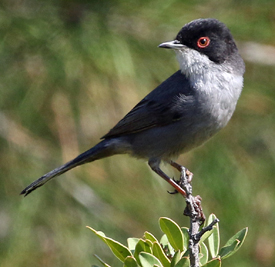 The Greek Island of Lesvos is renowned for its ancient history, incomparable natural beauty and tradition of hospitality. Celebrated as the Princess of the Northwest Aegean Sea, this stunning island has become known by birders as one of the best locations in Europe to witness spring migration. In late April and early May, a continual stream of migrating birds pass over the island as they move from their wintering grounds in Africa to their breeding grounds in Europe. Keen birders return year after year to experience the migration magic of Lesvos and search out the island’s special birds, including Krüper’s Nuthatch, Cinereous Bunting, Cretzschmar’s Bunting, Rüppell’s Warbler, Sardinian Warbler, Scopoli’s Shearwater, Isabelline Wheatear, Masked and Red-backed Shrike and more. This program will reveal the avian delights of Lesvos with vivid photographs of its birds against the backdrop of charming fishing villages, sea coasts, salt pans, sparkling rivers and lakes, and the slopes of Mount Olympus. The Greek Island of Lesvos is renowned for its ancient history, incomparable natural beauty and tradition of hospitality. Celebrated as the Princess of the Northwest Aegean Sea, this stunning island has become known by birders as one of the best locations in Europe to witness spring migration. In late April and early May, a continual stream of migrating birds pass over the island as they move from their wintering grounds in Africa to their breeding grounds in Europe. Keen birders return year after year to experience the migration magic of Lesvos and search out the island’s special birds, including Krüper’s Nuthatch, Cinereous Bunting, Cretzschmar’s Bunting, Rüppell’s Warbler, Sardinian Warbler, Scopoli’s Shearwater, Isabelline Wheatear, Masked and Red-backed Shrike and more. This program will reveal the avian delights of Lesvos with vivid photographs of its birds against the backdrop of charming fishing villages, sea coasts, salt pans, sparkling rivers and lakes, and the slopes of Mount Olympus.
Photos: Sardinian Warbler, Lesvos, April 2016 by Steve Bird.
Back to top
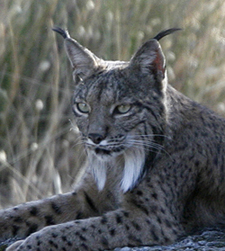 CHASING
WILD CATS CHASING
WILD CATS
Wild
cats are some of
the
world’s
most endangered
species
and their elusive
habits and secretive
lives capture our
imagination. This
program takes a
look at the wild
felines of the
world and what it
takes to see them
in their
native habitats.
Adventures in search
of the American
Puma, the Eurasian
Lynx, Jaguar, the
mythical
Snow Leopard, and
others are vividly
illustrated with
striking
photographs as
the
lives of some of
the
most endangered
and
mysterious creatures
in the world are
revealed.
Eurasian
Lynx. Photo by Steve
Bird.
Back
to top
COLOMBIA'S
AVIAN TREASURES
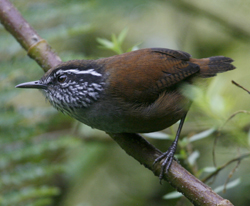 The
avian riches of Colombia
are legendary. With
at least 1870 species,
Colombia boasts more
species than any country
in the world! The country
holds at least 73 endemics
and 21 species new to
science discovered since
the first major field
guide was published
in 1986. From a birding
perspective, the opportunities
here are unsurpassed.
Until now however, Colombia
has been off limits
to birders. Security
concerns have kept Colombia
closed for decades.
In recent years, efforts
by the Colombian government
and military to address
safety problems have
significantly improved
the situation and Colombia
is now open for birding!
Gina Nichol spent the
better part of two months
birding Colombia in
2009 and has been working
with the Colombian government
and ornithological community
to develop tours to
this bird-rich country.
This program will reveal
the avian riches of
this once taboo birding
destination and depict
what it is like to bird
Colombia with vivid
photographs of many
of the colorful species
in this wonderful country. The
avian riches of Colombia
are legendary. With
at least 1870 species,
Colombia boasts more
species than any country
in the world! The country
holds at least 73 endemics
and 21 species new to
science discovered since
the first major field
guide was published
in 1986. From a birding
perspective, the opportunities
here are unsurpassed.
Until now however, Colombia
has been off limits
to birders. Security
concerns have kept Colombia
closed for decades.
In recent years, efforts
by the Colombian government
and military to address
safety problems have
significantly improved
the situation and Colombia
is now open for birding!
Gina Nichol spent the
better part of two months
birding Colombia in
2009 and has been working
with the Colombian government
and ornithological community
to develop tours to
this bird-rich country.
This program will reveal
the avian riches of
this once taboo birding
destination and depict
what it is like to bird
Colombia with vivid
photographs of many
of the colorful species
in this wonderful country.
Photo: Munchique
Wood Wren by Steve
Bird.
Back
to top
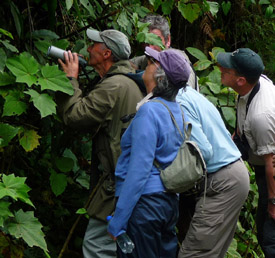 GOOD
LOOKING: How to
get better views
of birds! GOOD
LOOKING: How to
get better views
of birds!
One
of the most satisfying
aspects of bird watching
is getting a good close
view of a wild bird,
one that allows you
to study plumage features,
observe behavior or
simply enjoy the aesthetic
experience. Try as we
may, getting close to
birds is not so easy.
Binoculars and spotting
scopes help and most
birders know not to
wear white in the field
but what are some other
ways to improve your
chances of getting a
prolonged, satisfying
view of a bird? This
program will focus on "Fieldcraft",
the field practices
and specialist skills
for observing birds
at close range. Techniques
intended to advance
birding proficiency
and get those killer
views will be revealed
with the goal of raising
gratification and lowering
frustration that can
accompany our favorite
pursuit.
Photo: Birders
in Colombia by Gina
Nichol.
Back
to top
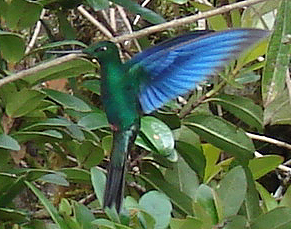 HUMMINGBIRDS:
Feathered Gems HUMMINGBIRDS:
Feathered Gems
With
more than 330 species
known
in the world, hummingbirds
are the second largest
family of birds
after flycatchers.
These tiny aeronautic
marvels have the
ability to hover,
fly backward, and
migrate long distances.
The physiological
capacity of hummingbirds
to raise and lower
their heart rate
and body temperature
to survive cold
nights is unmatched
in the animal world.
This program illustrates
the amazing adaptations
of these glittering
gems and describes
their fascinating
life histories.
Vivid photographs
of hummingbirds
in the United States,
Costa Rica, and
Ecuador tell the
story of how these
birds survive in
habitats that range
from tropical forests
to the forests of
the Andes Mountains.
Photo:
Great Sapphirewing
, Ecuador by Steve
Bird
Back
to top
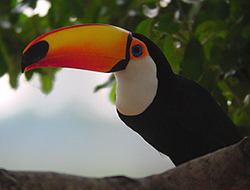 SAFARI BRAZIL SAFARI BRAZIL
The
seasonal
wetlands
of the
Pantanal
region
of west
central
Brazil
offer some
of South
America’s finest wildlife viewing opportunities. In an open, safari-type setting along the famous Transpantaneira Highway, spectacular concentrations of egrets, herons, storks, and ibis can be 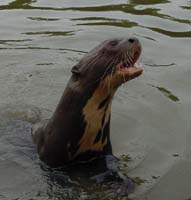 seen in vast, open wetlands. Five foot tall Greater Rheas (South America’s equivalent to the Ostrich) roam the open pasturelands. The air is filled with the raucous calls of Hyacinth, Red-and-Green, Red-bellied, Golden-collared Macaws and tropical animals including Yellow Anaconda, Black-and-Gold Howler Monkey, Crab-eating Fox, Giant Anteater, Capybara, and Jaguar live in the surrounding habitats. This program describes the stunning habitats and remarkable wildlife of the Pantanal region. Striking photographs illustrate the area’s extensive marsh and river habitats, huge waterfalls, cerrado, and gallery rainforest and vividly document its intriguing, exotic, wild residents. seen in vast, open wetlands. Five foot tall Greater Rheas (South America’s equivalent to the Ostrich) roam the open pasturelands. The air is filled with the raucous calls of Hyacinth, Red-and-Green, Red-bellied, Golden-collared Macaws and tropical animals including Yellow Anaconda, Black-and-Gold Howler Monkey, Crab-eating Fox, Giant Anteater, Capybara, and Jaguar live in the surrounding habitats. This program describes the stunning habitats and remarkable wildlife of the Pantanal region. Striking photographs illustrate the area’s extensive marsh and river habitats, huge waterfalls, cerrado, and gallery rainforest and vividly document its intriguing, exotic, wild residents.
Photos: Toco Toucan (right) & Giant Otter (left) by Gina Nichol.
Back
to top
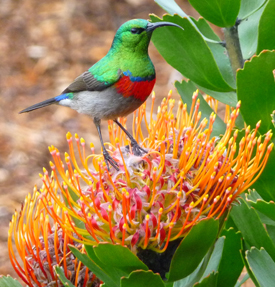 UNDER
SOUTH AFRICAN SKIES UNDER
SOUTH AFRICAN SKIES
The
southern tip of
Africa is one of
the greatest biodiversity
hotspots in the
world and attracts
birders, botanists
and mammal enthusiasts
from around the
globe. Harboring
a multitude of
endemic birds, the
classic African
mammals,
and a rich and
unique botanical
heritage, the multi-ethnic
nation of South
Africa stands out
as a wonderful
destination for
nature enthusiasts.
The Cape Peninsula,
often called the "Jewel
of South Africa",
offers spectacular,
wild, rugged
scenery that is
home to penguins,
ostriches, several
types of antelope,
and the unique "fynbos" vegetation.
Further into
the interior
of the country,
the world renowned
Kruger National
Park is one of
the largest game
reserves in Africa
and is home to
lions, leopards,
elephants, and
giraffes and
more than 500
species of birds.
This program
chronicles a
journey from
the Cape Peninsula
up to Kruger
National
Park with vivid
photos of birds,
animals and
stunning landscapes
and describes
what it is like
to travel in
this varied and
sometimes distinctly
un-African country.
Photo:
Southern Double-collared
Sunbird by Gina
Nichol.
Back
to top
|
 UPCOMING
TALKS by Gina Nichol UPCOMING
TALKS by Gina Nichol
Feedback:
Friday, April 7, 2023, Essex County Ornithological Club, Salem, MA
-- FLOCKOLOGY, Unraveling the Mysteries of Bird Flocks, 7PM, via Zoom
"Once again, your talk was super special and full of fun and fascinating facts! You are truly a consummate presenter (even when you can't see the audience!). People loved it and were clearly engaged! We had 106 households, which was a great turnout - especially on Good Friday! And they all stayed right up until the Q&A, which is the ultimate test."
Janey Winchell, Peabody Essex Museum, ECOC
Monday,
February 1, 2021,
Litchfield Hills
Audubon Society,
Litchfield, CT
--
LOOKING FOR OWLS,
7PM, via Zoom
"That
was an absolutely
stunning presentation,
beautifully put
together - carefully
thought out and
researched, and
of course superb
photos."
Angela
D., LHAS
"I’m
so glad that I was
able to join your
talk this evening.
It was so full of
realistic information
about looking for
owls. Well done!
You are an excellent
speaker, which I
knew you would be.
But you are also
an intuitive and thoughtful
creator of a presentation
with a goal. Really
meaty information! I
learned a lot and
really had a wonderful
time!"
Mary
Lou M, Chicago
Sunday,
August 19, 2018,
British Bird
Fair,
Rutland, England
--
LESVOS: Spring
Migration Magic,
10 AM,
Osprey Lecture
Theatre (LM1)
"Just
got back
from a
second day
at the
Rutland Birdfair.
We just
found most
of the
talks and
image shows
to be
on a
higher plane
than previous
years, and
one of
the real
highlights was
an excellent
presentation today
on Lesvos
by American
wildlife tour
leader Gina
Beebe Nichol.
Particularly
pleasing was that
Gina drummed home
to the large audience
that the magnificent
efforts by islanders
and others to deal
with the large passage
of refugees had little
effect on Lesvos as
a tourist/birding
destination.
We
went to several
great talks at Birdfair,
but our love for
Lesvos made Gina's
really stand out.
The audience certainly
loved it."
Frank
W., England
© Sunrise Birding. All rights reserved.
All photos by Gina Nichol unless otherwise noted.
Contact Gina Nichol at [email protected]
|
 The
avian riches of Colombia
are legendary. With
at least 1870 species,
Colombia boasts more
species than any country
in the world! The country
holds at least 73 endemics
and 21 species new to
science discovered since
the first major field
guide was published
in 1986. From a birding
perspective, the opportunities
here are unsurpassed.
Until now however, Colombia
has been off limits
to birders. Security
concerns have kept Colombia
closed for decades.
In recent years, efforts
by the Colombian government
and military to address
safety problems have
significantly improved
the situation and Colombia
is now open for birding!
Gina Nichol spent the
better part of two months
birding Colombia in
2009 and has been working
with the Colombian government
and ornithological community
to develop tours to
this bird-rich country.
This program will reveal
the avian riches of
this once taboo birding
destination and depict
what it is like to bird
Colombia with vivid
photographs of many
of the colorful species
in this wonderful country.
The
avian riches of Colombia
are legendary. With
at least 1870 species,
Colombia boasts more
species than any country
in the world! The country
holds at least 73 endemics
and 21 species new to
science discovered since
the first major field
guide was published
in 1986. From a birding
perspective, the opportunities
here are unsurpassed.
Until now however, Colombia
has been off limits
to birders. Security
concerns have kept Colombia
closed for decades.
In recent years, efforts
by the Colombian government
and military to address
safety problems have
significantly improved
the situation and Colombia
is now open for birding!
Gina Nichol spent the
better part of two months
birding Colombia in
2009 and has been working
with the Colombian government
and ornithological community
to develop tours to
this bird-rich country.
This program will reveal
the avian riches of
this once taboo birding
destination and depict
what it is like to bird
Colombia with vivid
photographs of many
of the colorful species
in this wonderful country.
 SAFARI BRAZIL
SAFARI BRAZIL seen in vast, open wetlands. Five foot tall Greater Rheas (South America’s equivalent to the Ostrich) roam the open pasturelands. The air is filled with the raucous calls of Hyacinth, Red-and-Green, Red-bellied, Golden-collared Macaws and tropical animals including Yellow Anaconda, Black-and-Gold Howler Monkey, Crab-eating Fox, Giant Anteater, Capybara, and Jaguar live in the surrounding habitats. This program describes the stunning habitats and remarkable wildlife of the Pantanal region. Striking photographs illustrate the area’s extensive marsh and river habitats, huge waterfalls, cerrado, and gallery rainforest and vividly document its intriguing, exotic, wild residents.
seen in vast, open wetlands. Five foot tall Greater Rheas (South America’s equivalent to the Ostrich) roam the open pasturelands. The air is filled with the raucous calls of Hyacinth, Red-and-Green, Red-bellied, Golden-collared Macaws and tropical animals including Yellow Anaconda, Black-and-Gold Howler Monkey, Crab-eating Fox, Giant Anteater, Capybara, and Jaguar live in the surrounding habitats. This program describes the stunning habitats and remarkable wildlife of the Pantanal region. Striking photographs illustrate the area’s extensive marsh and river habitats, huge waterfalls, cerrado, and gallery rainforest and vividly document its intriguing, exotic, wild residents. UNDER
SOUTH AFRICAN SKIES
UNDER
SOUTH AFRICAN SKIES 

 NEW!
NEW! NEW!
NEW! NEW!
NEW! The Greek Island of Lesvos is renowned for its ancient history, incomparable natural beauty and tradition of hospitality. Celebrated as the Princess of the Northwest Aegean Sea, this stunning island has become known by birders as one of the best locations in Europe to witness spring migration. In late April and early May, a continual stream of migrating birds pass over the island as they move from their wintering grounds in Africa to their breeding grounds in Europe. Keen birders return year after year to experience the migration magic of Lesvos and search out the island’s special birds, including Krüper’s Nuthatch, Cinereous Bunting, Cretzschmar’s Bunting, Rüppell’s Warbler, Sardinian Warbler, Scopoli’s Shearwater, Isabelline Wheatear, Masked and Red-backed Shrike and more. This program will reveal the avian delights of Lesvos with vivid photographs of its birds against the backdrop of charming fishing villages, sea coasts, salt pans, sparkling rivers and lakes, and the slopes of Mount Olympus
The Greek Island of Lesvos is renowned for its ancient history, incomparable natural beauty and tradition of hospitality. Celebrated as the Princess of the Northwest Aegean Sea, this stunning island has become known by birders as one of the best locations in Europe to witness spring migration. In late April and early May, a continual stream of migrating birds pass over the island as they move from their wintering grounds in Africa to their breeding grounds in Europe. Keen birders return year after year to experience the migration magic of Lesvos and search out the island’s special birds, including Krüper’s Nuthatch, Cinereous Bunting, Cretzschmar’s Bunting, Rüppell’s Warbler, Sardinian Warbler, Scopoli’s Shearwater, Isabelline Wheatear, Masked and Red-backed Shrike and more. This program will reveal the avian delights of Lesvos with vivid photographs of its birds against the backdrop of charming fishing villages, sea coasts, salt pans, sparkling rivers and lakes, and the slopes of Mount Olympus CHASING
WILD CATS
CHASING
WILD CATS
 HUMMINGBIRDS:
Feathered Gems
HUMMINGBIRDS:
Feathered Gems